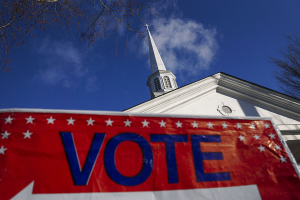The Planet of the Apes and Christian Eschatology
Today I launched a new semester of my Doctrine of the Last Things class, with the showing of a clip from the movie The Planet of the Apes.
The clip my students watched was in the closing moments of the 1968 film, as Charlton Heston is fleeing a civilization in which gorillas, chimpanzees, and orangutangs rule over non-verbal, animal-like human beings. Up to this point, Heston's character assumes he's on another planet, one that has evolved differently from life on earth. The final scene though tells the shocking truth.
Heston sees the Statue of Liberty in ruins, up to her torso in mud and sand. It's then that he realizes he hasn't traveled through space, but through time. He sees the wreckage of a civilization lost.
Contrast the ending of the 1968 film with the ending of the 2001 remake. In a similar attempt at a twist climax, the protagonist (this time, Mark Wahlberg) escapes the ape planet in his space ship, crash-landing in Washington D.C., skipping across the mall past the Washington Monument and the Reflecting Pool, to land right in front of the Lincoln Memorial.
Like Heston, Wahlberg is horrified by a national monument gone awry. In his case, it's the Lincoln Memorial-with Lincoln's face a chimpanzee. Wahlberg learns to his terror he hasn't escaped at all.
And then, of course, there's the most recent Planet of the Apes film, The Rise of the Planet of the Apes (2011), starring James Franco. In this version, the apes are genetically mutated by a well-meaning scientist seeking a cure for Alzheimer's Disease. The hyper-intelligent apes escape, begin reproducing and lash back against their human perfecters. Again, the closing scene is meant to be chilling-the redwood trees of northern California filled with primates staring out over the Golden Gate Bridge and the San Francisco Bay.
All three of these movies, I insisted to my students, are about the intersection of eschatology with contemporary fears.
In the 1968 version, the era is worried about nuclear holocaust, as the U.S. and the Soviet Union are engaged in a high-stakes Cold War. By the remake in 2001, society's fears focus on the more imperceptible threats of domestic and international terrorism, and of the loss of society from within. The 2011 film focuses on the fear of a future in which our technological prowess and our good intentions turn on us.
All three present a dystopian future in which our worst apprehensions are realized. That's an eschatology, and a dark one.
The same point could be made with virtually every film and art genre. In the background or in the foreground, there's a purpose, a goal, that's either hopeful or tragic. Even in the realm of romantic dramas, there's either a utopian goal (the "happily ever after") or a dystopian end (the tragedy of love lost). But, whatever the genre, we have to live in light of the future.
As I went around the room with my students, I asked what their home churches had taught about the ultimate things: heaven, hell, kingdom, and so on. Most of them said their churches were reluctant to say much at all, beyond generalities. Many of their churches, it seems, were fearful to talk much about eschatology to keep from indulging in those speculative end-times enthusiasts we've all encountered.
But eschatology and discipleship in the church is kind of like sex education in the home. Just because you don't talk about sex with your kids doesn't mean they will grow up ignorant of sex. It means they'll hear about sex from somewhere else.
Just because you don't preach and teach about the Christian vision of the future, that doesn't mean your church is void of eschatology. It means your church is picking up an eschatology from somewhere else, sometimes from the local cineplex.
A Christian vision of the future proves the dystopian movies to be right, in some sense. There's a fire being kindled somewhere, and not even the Statue of Liberty can withstand it. But, after that, there's the kind of new creation that makes everything new.




























